This commentary is based on a longer paper by the author titled “Currency Conversion during the Period of Transition: The Case of North Korea,” presented at an IMF-SNU conference on 17-18 June 2008 and at a Brookings CNAPS seminar on 13 November 2008.
Recent news reports on the absence of North Korean leader Kim Jong-Il from important functions have sparked speculation about his health and North Korea’s future. Since very little is known about North Korea, the spectrum of anticipated scenarios after Kim is very wide, but can be divided broadly into two groups.
One group thinks that a collective leadership among the party, the military, and the security apparatus is likely to emerge and that North Korea will follow a gradual and step-by-step transformation. The other group, in contrast, puts more weight on the possibility of North Korea’s collapse: in this case, it is presumed that an enormous exodus of refugees will flow from North Korea to South Korea, China, and even Japan and that the Korean peninsula may be placed in a very risky situation.
Although stability and gradual reform is the most desirable scenario for North Korea, we don’t know at all what will happen. It is anybody’s guess how North Korea will change after Kim Jong-Il’s departure. But it is certain that Kim’s health problems have created a sense of urgency in preparing against a worst case scenario. Some movements in this direction have already been recognized: for example, it was reported that U.S. has proposed that South Korea quickly develop the contingency plan (CONPLAN 5029) into an action plan (OPLAN 5027) in case of North Korea collapse.
It is also clear that preparing for change after the death of Kim requires both the development of a very comprehensive plan and attention to specific issues. This short article addresses one of those issues: monetary unification. In particular, how will a conversion rate be determined between North Korean currency and South Korean currency (or another foreign currency such as the U.S. dollar); and when during the unification process should the two currencies be integrated. For purposes of analysis, I assume that the two Koreas will eventually be unified and that the unification will follow a rapid process rather than a gradual one.
Choice of Conversion Rates
The establishment of an appropriate conversion rate is very important in transforming the North Korean economy. A proper rate can stabilize the economy, encourage trade at undistorted prices, and even speed up the process of transition to a more market-based economy. But it is very difficult to find an appropriate rate for the North Korean currency, in particular because the data on North Korea’s economy are very limited.
Given the difficulty, one may be tempted to use existing exchange rates.[1] According to the official trade exchange rate, the value of the North Korean won against the U.S. dollar had been stable at around 2.20 won to the dollar before the reform in July 2002. After July 2002, the official exchange rate jumped nearly 70 times to a rate of 153.50 : 1. However, the won has steadily depreciated in the unofficial market. One North Korean won is now considered worth only 1/3000 of one U.S. dollar, or one third of the South Korean won, in the free market. Obviously, there is a huge gap between the official and unofficial rates.
<Figure 1> Official exchange rates (North Korean wons per U.S. dollar)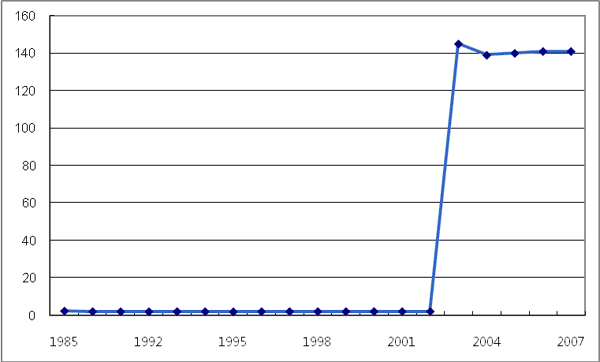
<Figure 2> Unofficial exchange rates (North Korean wons per U.S. dollar)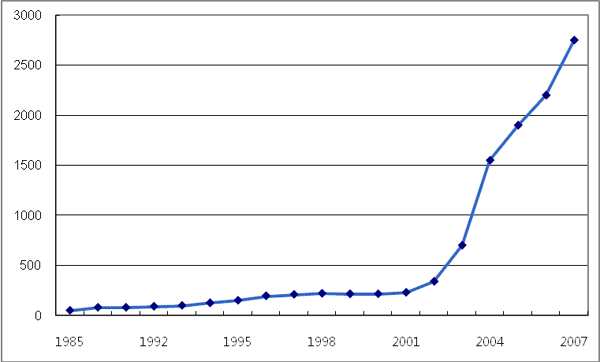
<Figure 3> Gap ratio of unofficial rate to official rate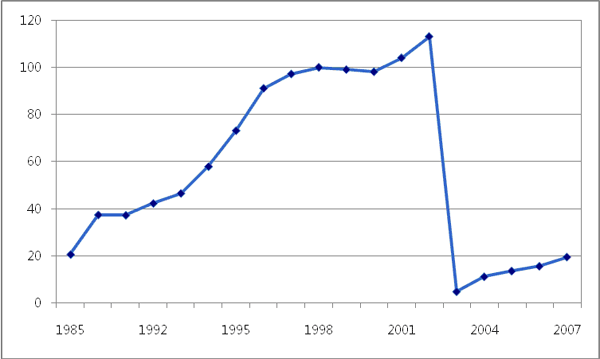
This trend implies that the official trade exchange rate is not at all reliable and of no economic significance. But using the unofficial rate is also problematic. Data are collected only sporadically and vary significantly depending upon the sources. Also, users generally prefer foreign currencies to North Korean currency; thus, the unofficial rate includes a high premium for foreign currencies and hardly reflects the North Korean economy. This suggests that we need to estimate a conversion rate using available data so that the rate can better reflect changes in the North Korean economy.
Despite the limited and inaccurate figures, there are some data that could be used for calculation of conversion rates. For example, as unofficial markets such as farmer’s and black markets are expanded, their price data exhibit price flexibility and reflect market changes. Thus, we may be able to collect information on a conversion rate that is included in currently available data. Also, despite some drawbacks of traditional models of exchange rate determination, two approaches – PPP (purchasing power parity) approach and monetary approach – are applicable to the case of North Korea even with limited and incomplete data.
According to the PPP approach, the exchange rate between two currencies is determined by the ratio of the two countries’ price levels. Following a process similar to that of the ICP (International Comparison Project) of the World Bank for empirical analysis uncovered some noteworthy results. First, there was a huge gap between conversion rates based on the official PDS (price distribution system) price data and those based on unofficial price data. Second, the gap between the two exchange rates is much wider in the agricultural sector than in the non-agricultural sector. This implies that the food problem was very serious in North Korea, more serious than the decline of the economy in general. Third, despite the reform in 2002 which narrowed the gap between official and unofficial prices in the short term, the gap remains and has begun widening again in recent years. It implies that the reform is not yet functioning as expected.
The second monetary approach produces similar results. According to the monetary approach, a certain amount of money is needed to support economic activity. So, when the two Koreas are unified, if the North Korean economy is 1/10 the size of the South Korean economy, the added money from North Korea should be 1/10 the amount of South Korean money so that there is no additional inflationary pressure. Comparing South Korean and North Korean GDPs and their monetary stocks,[2] we can calculate the rate to convert North Korean currency to South Korean currency. The basic implications are similar to those using price data. During the 1990s, the value of the North Korean won plunged and the gap between the official and unofficial rates widened. Even after the 2002 reform, the North Korean currency seems to have lost significant value; North Korea’s monetary stock is believed to be much larger now than before, and accordingly the value of the North Korean won now seems much lower than before.
The calculation of conversion rates based on the PPP and monetary approaches suggests that one North Korean won is recently worth less than 1/1000 of one U.S. dollar, or less than one unit of South Korean currency. With better and more complete data we may be able to calculate the rates more accurately and use them as a guide to convert North Korean currency during monetary unification. But an equilibrium rate that well reflects the market is not necessarily optimal for unification. The choice of a conversion rate for unification requires additional consideration: the conflicting effects of a conversion rate choice on various policy objectives – such as price (and macroeconomic) stability, firms’ competitiveness and job opportunities, the standard of living of local residents, and the government budget – must be examined.
For example, an overvaluation of North Korean currency will increase the injection of additional money into a unified Korea and produce inflationary pressure. Thus in terms of the inflation criterion, the choice of a conversion rate undervaluing North Korean currency would be desirable. Also, if North Korean currency is overvalued, it will hurt the competitiveness of North Korean firms and reduce job opportunities in North Korea; the undervaluation of North Korean currency would be desirable in this respect as well. On the other hand, an overvaluation of North Korean currency can increase wage payments and the value of financial assets for North Korean residents, creating a short-term positive effect on the standard of living. Finally, the overvaluation of North Korean currency may have either a positive or negative effect on the government budget,.
The decision on a conversion rate will depend upon which policy objective is the most important. Considering their relative impacts and past experiences, I suggest that price/macroeconomic stability and competitiveness of North Korean industries should have the high priority: undervaluation of North Korean currency is therefore more desirable.[3] The experiences of other socialist countries show that inflation was one of the most difficult problems at the beginning of economic reforms. Even though the details of each country’s reform path depend upon the state of the economy, price/macroeconomic stabilization has to be the initial priority. Once price/macroeconomic stability is guaranteed, foreign capital – which North Korea eagerly needs for its successful transformation and development – can be attracted.
The undervaluation of North Korean currency is also desirable in terms of labor migration. According to studies on German unification,[4] the most important reason for migration from East to West was not the high incomes in West Germany, but the lack of job opportunities in East Germany. This implies that the overvaluation of North Korean currency to improve the standard of living of the North Korean people would cause more migration because of suffering competitiveness of North Korean firms and job opportunity, and would further place a higher burden on the government budget.
Timing of Currency Unification
Another major issue will be the timing of monetary integration during the unification process. There are of course pros and cons between an early currency union and a late currency union.[5] For example, an early union would remove uncertainties about the unification and provide an important symbol for the unification. It would also lead to quick macroeconomic stability in North Korea and attract foreign investment. In addition, an early currency union would reduce transaction costs and encourage interregional transactions, speeding up economic reforms in North Korea. But an early union has several drawbacks as well. For example, an early union results in the loss of the exchange rate policy instrument which may be needed for absorbing shocks. Also, since we most likely will not have much information on the North Korean economy in the early stages of the unification, there is serious risk of establishing an inappropriate conversion rate based on incorrect or incomplete information, which would cause serious costs, such as the devastation of North Korean industries and labor migration. Such a misstep would destabilize the North Korean economy and hinder economic reforms.
The German experience of an early currency union revealed many problems with this model and some suggest that a later currency union would be more desirable for Korea. But a late currency union has also both benefits and costs. To choose the timing, we need to understand not only the effects on policy objectives but also the feasibility of alternatives and the status of the North Korean economy. With these factors in mind, I suggest that an early currency union is preferable to a late one.
First, most proponents of a late currency union argue that currency unification needs to be delayed for a few years until North Korean economy is stabilized and improves to a certain level. However, a temporary delay of a few years will not guarantee the improvement of the North Korean economy to a certain level but is more likely to lead to its deterioration. Even though the North Korean economy may improve, it actually must grow much faster than South Korean economy for a long time to reach a certain compatible level. For example, even assuming North Korean economic growth of 10 percent per year – which would be extremely difficult – it will still take nearly one generation for North Korean per capita income to reach one half of the South Korean level. This suggests that it is impossible to improve the North Korean economy to a certain level compatible with South Korea’s within a few years. Thus, in terms of feasibility, an early union is better.
Second, a gradual strategy for economic reform and opening, such as China has chosen, would not be applicable to North Korea. In comparison with China, North Korea is over-industrialized like Eastern European countries. In this type of economy where the state sector is dominant, there is little reserve of labor outside the state sector that can provide the engine for growth for a new non-state sector, and gradualism cannot work in that context. A sharp downturn in industrial production upon the outset of market reforms is inevitable, and a significant loss of employment in the industrial sector should be expected and accepted as a structural adjustment in North Korea. Thus, the unified fiscal and monetary policy framework to promote structural reforms should be prepared as soon as possible through an early currency union.
Third, according to the theory of optimum currency area, if there exists an adjustment mechanism such as flexible prices and wages or other measures to absorb asymmetric shocks, it is more likely for two countries to form an optimum currency area. When the two Koreas are unified, large fiscal transfers from South Korea to North Korea can play that role of adjustment mechanism because asymmetric shocks to North Korea can be compensated by these fiscal transfers. The two Germanys could form an optimum currency area after the unification because of the centralization of the fiscal system. Thus, as long as fiscal transfers are guaranteed, which will be a sure fact in the case of Korean unification, the loss of the exchange rate policy instrument would not matter much in terms of absorbing asymmetric shocks, and an early monetary union is preferable.
[1] In North Korea, there used to be various kinds of exchange rates such as the official exchange rate, the trade exchange rate, the traveler’s exchange rate, and unofficial exchange rates (farmer’s market and black market exchange rates). The official and the traveler’s exchange rates appear to have been abolished around the beginning of the 1990s. The trade exchange rate is currently considered the official exchange rate.
[2] North Korean monetary stocks were estimated benchmarking ex-socialist countries’ data and using survey data from North Korean refugees.
[3] When we actually convert North Korean currency to South Korean currency during unification, we will need to apply different conversion rates to different cases. But it is still better that on average those rates undervalue North Korean currency.
[4] Akerlof, G., A. Rose, J. Yellen, and H. Hessenius (1991), “East Germany in from the Cold: The Economic Aftermath of Currency Union,” in W. Brainard and G. Perry (eds.), Brookings Papers on Economic Activity 1, Brookings Institution.
[5] An early currency union would integrate the two currencies at the beginning stage, before political and economic unification while a late currency union would maintain two separate currencies until the last stage of the whole unification process.

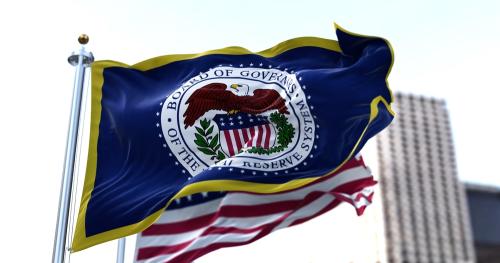
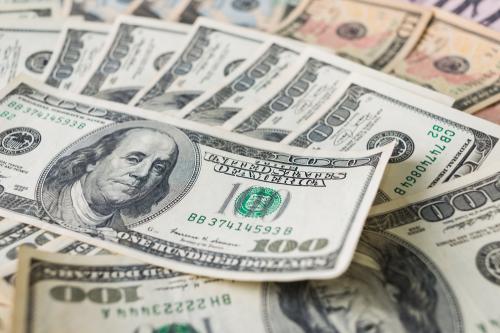
Commentary
Op-edCurrency Conversion during Korean Unification
January 6, 2009